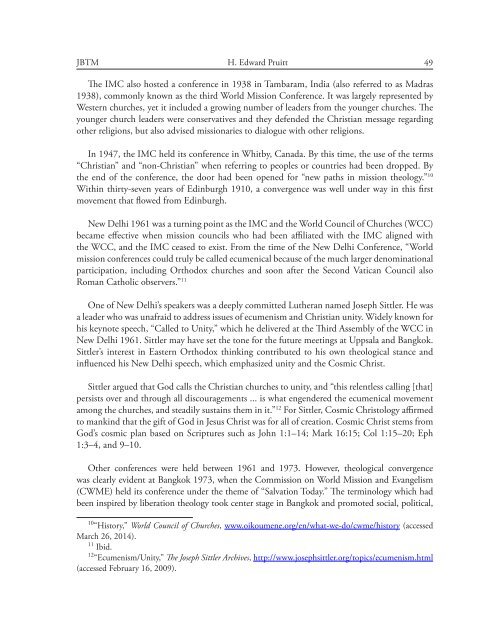JBTM_10-2_Fall_2013
JBTM_10-2_Fall_2013
JBTM_10-2_Fall_2013
Create successful ePaper yourself
Turn your PDF publications into a flip-book with our unique Google optimized e-Paper software.
<strong>JBTM</strong><br />
H. Edward Pruitt<br />
49<br />
The IMC also hosted a conference in 1938 in Tambaram, India (also referred to as Madras<br />
1938), commonly known as the third World Mission Conference. It was largely represented by<br />
Western churches, yet it included a growing number of leaders from the younger churches. The<br />
younger church leaders were conservatives and they defended the Christian message regarding<br />
other religions, but also advised missionaries to dialogue with other religions.<br />
In 1947, the IMC held its conference in Whitby, Canada. By this time, the use of the terms<br />
“Christian” and “non-Christian” when referring to peoples or countries had been dropped. By<br />
the end of the conference, the door had been opened for “new paths in mission theology.” <strong>10</strong><br />
Within thirty-seven years of Edinburgh 19<strong>10</strong>, a convergence was well under way in this first<br />
movement that flowed from Edinburgh.<br />
New Delhi 1961 was a turning point as the IMC and the World Council of Churches (WCC)<br />
became effective when mission councils who had been affiliated with the IMC aligned with<br />
the WCC, and the IMC ceased to exist. From the time of the New Delhi Conference, “World<br />
mission conferences could truly be called ecumenical because of the much larger denominational<br />
participation, including Orthodox churches and soon after the Second Vatican Council also<br />
Roman Catholic observers.” 11<br />
One of New Delhi’s speakers was a deeply committed Lutheran named Joseph Sittler. He was<br />
a leader who was unafraid to address issues of ecumenism and Christian unity. Widely known for<br />
his keynote speech, “Called to Unity,” which he delivered at the Third Assembly of the WCC in<br />
New Delhi 1961. Sittler may have set the tone for the future meetings at Uppsala and Bangkok.<br />
Sittler’s interest in Eastern Orthodox thinking contributed to his own theological stance and<br />
influenced his New Delhi speech, which emphasized unity and the Cosmic Christ.<br />
Sittler argued that God calls the Christian churches to unity, and “this relentless calling [that]<br />
persists over and through all discouragements ... is what engendered the ecumenical movement<br />
among the churches, and steadily sustains them in it.” 12 For Sittler, Cosmic Christology affirmed<br />
to mankind that the gift of God in Jesus Christ was for all of creation. Cosmic Christ stems from<br />
God’s cosmic plan based on Scriptures such as John 1:1–14; Mark 16:15; Col 1:15–20; Eph<br />
1:3–4, and 9–<strong>10</strong>.<br />
Other conferences were held between 1961 and 1973. However, theological convergence<br />
was clearly evident at Bangkok 1973, when the Commission on World Mission and Evangelism<br />
(CWME) held its conference under the theme of “Salvation Today.” The terminology which had<br />
been inspired by liberation theology took center stage in Bangkok and promoted social, political,<br />
<strong>10</strong> “History,” World Council of Churches, www.oikoumene.org/en/what-we-do/cwme/history (accessed<br />
March 26, 2014).<br />
11<br />
Ibid.<br />
12 “Ecumenism/Unity,” The Joseph Sittler Archives, http://www.josephsittler.org/topics/ecumenism.html<br />
(accessed February 16, 2009).


